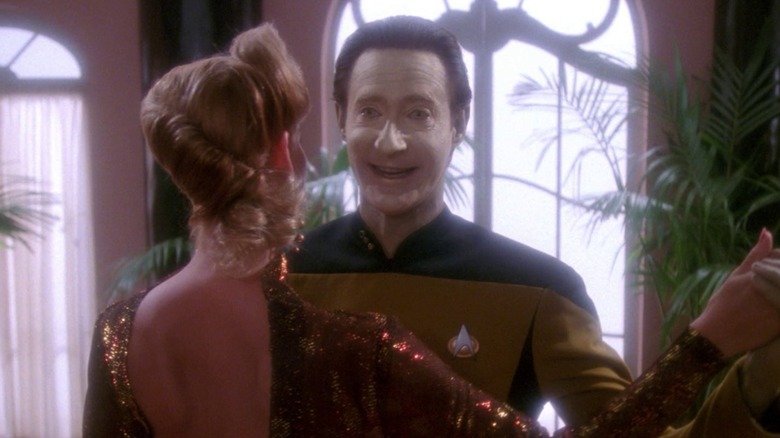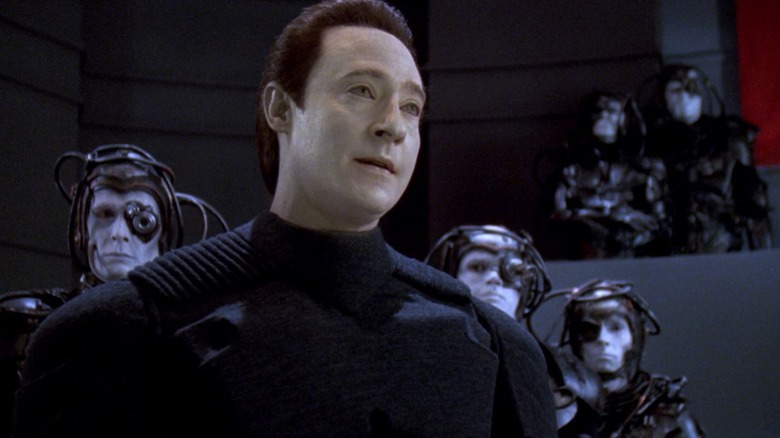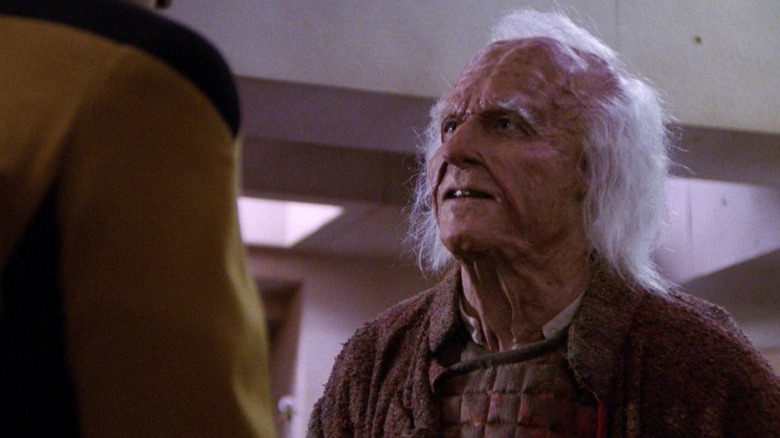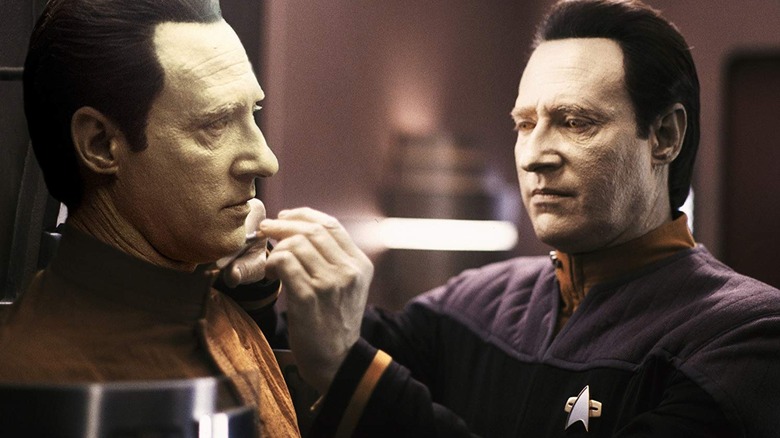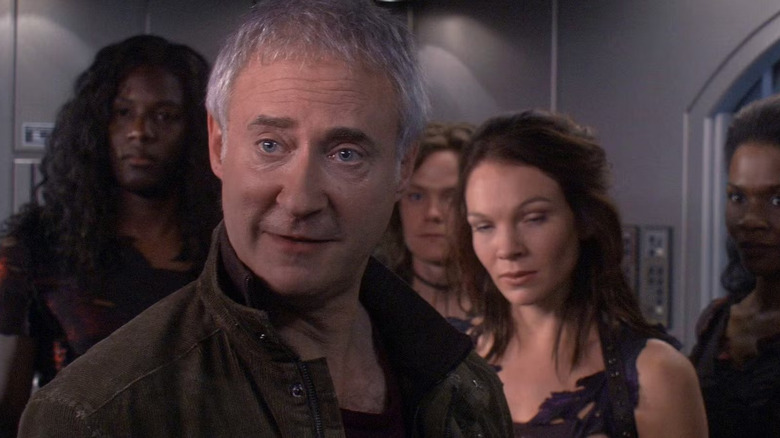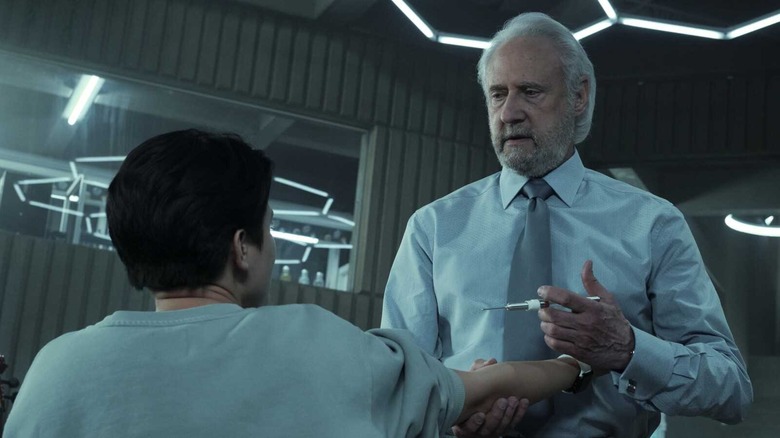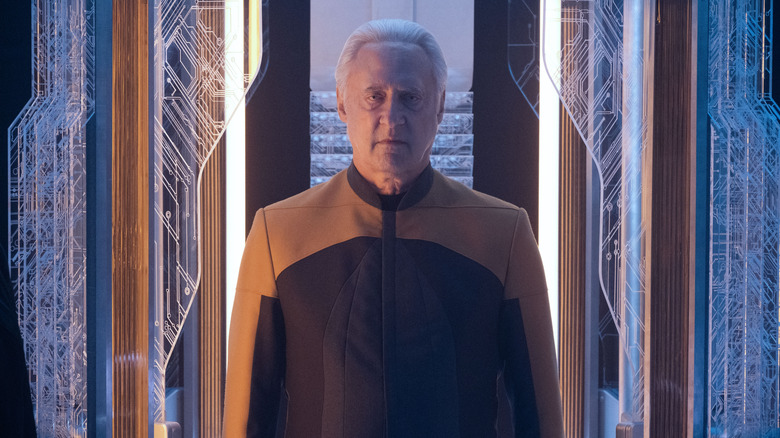Every Star Trek Character Played By Brent Spiner, Explained
Data, the android played by Brent Spiner, was beloved by the writers of "Star Trek: The Next Generation." Apart from Captain Picard (Patrick Stewart), Data had the most number of episodes devoted to him. Data was emotionless but aspired to be human, giving him a unique perspective on the human condition. He would ask fundamental queries like "What is humor?" or "Describe feeling angry," allowing the Trekkies watching to formulate answers in their minds. Data's questions allowed viewers to become more articulate about the human experience, which is good, just in case we meet an android in person.
Spiner was also such a versatile actor that he was frequently asked to play other characters. Data became possessed by an evil alien criminal in the episode "Power Play" (February 17, 1992), for instance. In the episode "A Fistful of Datas" (November 9, 1992), an Old West holodeck program began reproducing duplicates of Data, all played by Spiner. In the (maligned) episode "Masks" (February 21, 1994), Data was possessed by hundreds of extinct alien people. He played a holographic Musketeer in "Hollow Pursuits" (April 30, 1990) and was possessed by Ira Graves (W. Morgan Sheppard) in "The Schizoid Man" (January 23, 1989). For a character who had no emotions, Data had some of the most emotional roles.
Spiner has been part of the "Star Trek" firmament since the start of "Next Generation" in 1987, and he has appeared every episode of the series, all four of its spinoff movies, and he turned up on several episodes of "Star Trek: Enterprise," "Star Trek: Picard," and one episode of "Star Trek: Lower Decks."
Aside from those aforementioned roster, here are all the key characters that Brent Spiner has played across the "Star Trek" canon.
Data
Data, as described above, is a fantastic science fiction creation. Data was humane and gentle but also cold, as he had no emotions. Or at least he claimed not to. Data often expressed forms of perplexity, curiosity, ambition, justice, ennui, and — in at least one case (as in "The Most Toys") — outright rage. His emotions were mostly subtle, however, a mere expression of his positronic matrix. Data is often compared to Spock (Leonard Nimoy) from the original "Star Trek," as he was also an emotionless being on the bridge of the Enterprise. Data, however, aimed to be more human, while Spock always strove to be less.
Data's backstory was laid out clearly in the early episodes of "Next Generation." He was constructed by a rogue genius cyberneticist named Dr. Noonien Soong, who was presumably killed by a marauding alien. Data was discovered without memories on a desolated planet and activated. Having been cared for by Starfleet officers, Data found the job to be appealing, and he was allowed to attend Starfleet Academy. Dr. Soong, it seems, was such a uniquely brilliant scientist that no scientists have been able to reproduce an android as sophisticated as Data. This makes Data more or less unique in the world of "Star Trek." It's also a handy dramatic device for the "Next Generation" writers, as it ensured that Data clones would remain at a relatively low ebb.
Spiner loved playing Data. He also kind of hated it.
Lore
Lore was Data's evil twin brother. He, too, was created by Dr. Soong, but he was programmed to feel emotions. Sadly, Lore's positronic brain wasn't perfect, and he began to develop strong impulses toward jealousy, resentment, sadism, and violence. At first, Lore said that Data had been created first as a prototype, and Lore was the more perfect android model, but it would later be revealed that Lore was lying, and he was the more rudimentary model. It would also later be revealed that Lore was in league with a massive, planet-eating Crystalling Entity that he lured to his home planet specifically to murder the humans who created him. Lore, as one can see, had no love for organic beings.
Lore also had no ambitions to be human, but he did have a lot of hate. In the episode "Brothers" (October 8, 1990), Lore did express some sadness and distress when he learned that Dr. Soong (see below) was dying of old age. For the most part, though, Lore was a bitter adolescent, annoyed by everything and eager to take control of others. Indeed, in the two-part episode "Descent" (June 21 & September 20, 1993), Lore even became the leader of a cult of Borgs who had separated from their collective. He was a dark messianic figure. He was eventually deactivated, only returning as a vision in an episode of "Star Trek: Picard" many years later.
Fun trivia: The Lore story undid an original idea to make Data an alien-crafted being.
Dr. Noonien Soong
As mentioned, Dr. Noonien Soong was presumed dead when Data was discovered by Starfleet officers. In the episode "Brothers," however, it would be revealed that he was still alive ... albeit barely. The very, very elderly Dr. Soong was dying, but he activated an android beacon that attracted Data to his location. Without intending to, the beacon also attracted Lore, and "Brothers" allowed Brent Spiner to play three different roles in the same room.
Soong seemed to be a little bitter, in a typically curmudgeonly way, and spoke very frankly to Data and Lore. When Data asks why he was created, Soong, in a very Plato-like way, answers with a question. Why does anyone have children? Data thinks it out, and comes to conclusion that most people want a piece of themselves to live on in perpetuity.
Data was to be given an emotions chip by Dr. Soong, essentially fast-tracking his development toward humanity. Sadly, Lore was so bitter about his treatment by his father that he took Data's place in secret and stole the emotions chip for himself. Perhaps the chip drove him a little more mad. In the ensuing fracas, Dr. Soong is knocked over, which was enough to kill him. A tragic end for an ambitious father.
B-4
In the 2002 feature film "Star Trek: Nemesis," Data learned of a brother he never knew he had. Scattered in pieces on a distant world, Data discovered B-4, a Soong android prototype that he seemingly built before Lore or Data. B-4 was a rudimentary model with a simpler brain than his brothers, and he behaved like a toddler. For example, when he sees Commander Riker (Jonathan Frakes), he asks why the tall man has a furry face.
B-4, we later learn, was scattered in pieces across the aforementioned distant world as bait for Captain Picard. If the U.S.S. Enterprise detected a rare Soong android, they would most certainly be drawn there to look. Shinzon (Tom Hardy), a clone of Picard, put B-4 there as a way to lure the Enterprise to his location. Sadly, it's never explained how Shinzon got his hands on a Soong android, and the screenwriters ignore the coincidence that Shinzon, of all people, should have found it, seeing as he already wanted to target Picard and the Enterprise.
Data died at the end of "Star Trek: Nemesis," sacrificing his life to save the Enterprise from an attack by Shinzon's ship, the Scimitar. Before he died, however, he uploaded all of his memories into B-4's brain, implying that Data would, in some way, live on. B-4 never really expressed any kind of sophisticated emotions, though, and hebarely seemed to perceive the world around him. Perhaps Data's memories were meant to make him grow up.
Arik Soong
"Star Trek: Enterprise" took place a century before the events of the original "Star Trek" series, allowing Spiner to return to play an ancestor of Dr. Noonien Soong. Arik Soong appeared in a three-part story arc in the fourth season of "Enterprise" that incorporated the episodes "Borderland," "Cold Station 12," and "The Augments" (October 29, November 5, and November 12, 2004). Arik Soong was a somewhat villainous character who was a little too keen on tinkering around with human genomes and making ultra-strong super-soldiers. Eugenics, to remind the reader, has been strictly outlawed in the world of "Star Trek," as a previous bout with genetic manipulation created super-soliders who took over the world during the Eugenics Wars. Khan (Ricardo Montalbán) was one of the soldiers.
Arik Soong is Noonien Soong's great-grandfather, and his three-part "Enterprise" arc involved an escaped band of genetically enhanced convicts — considered to be Arik's "children" — who sought to acquire a secret store of super-embryos stored at a Cold Station in a dangerous area of space. The convicts, called Augments, ended up butting heads with Arik over their violent means. Arik, meanwhile, had already manipulated the next generation of Augments to be less violent. Arik, while ultimately eschewing violence, wasn't a great guy. He believed in breeding "superior" humans.
When his plans to do so via genetics didn't work, he figured he'd have to build an ideal human. An android maybe. It would take a long time to perfect, though. Maybe a few generations ... The Soongs that came after Arik were all android enthusiasts.
Fun trivia: The Big Show was in one of the Arik episodes.
Altan Soong
It seems that Noonien Soong also had a biological son, in addition to the three androids he built. One can infer that the Soongs were all possessed of some egomania, seeing as they wanted all their androids to resemble them. And who is to say that Noonien Soong didn't also genetically manipulate his son to look just like him? Indeed, there's every reason to assume that Altan is a clone of Noonien.
Altan Soong appeared in the final episodes of the first season of "Star Trek: Picard," and he was seen living on a private androids-only planet. The first season of "Picard" took place several decades after the events of "Nemesis," after the Federation had lived through several cataclysms. One of those cataclysms was a mysterious android uprising wherein brainless slave-bots had suddenly taken up weapons and started killing their masters. The androids in question weren't sentient, which made their uprising very strange. A vaguely defined galactic treaty was immediately signed, banning the further development of artificial life forms. It will later be revealed that the robot uprising was orchestrated by a shadowy cabal of Romulans who hated androids. It all had something to do with a robotic Cthulhu from another dimension.
Anyway, Altan, wanting to defend androids, moved to a secret world where hundreds of androids lived in an Edenic paradise. He was a gentle guy, and he didn't have a lot to add to the plot. Altan built a super-advanced android golem that could house a whole human consciousness, which he would use on Picard. Yes, Picard is an android now. Also, Altan will later reveal that he built an android called Android M-5-10 (more on that later).
Adam Soong
In the second season of "Star Trek: Picard," the title Admiral travels back in time to the year 2024 to solve a complex mystery about a split timeline. He had seen an alternate future wherein humans had become violent, genocidal tyrants who were killing off every other species in the galaxy. In that alternate future, humans' genocidal philosophy stemmed from the ideas of one Adam Soong, who — like Arik on "Enterprise" — believed that humans were genetically superior to other life forms.
Picard met up with Adam in 2024, and he was indeed tinkering with human DNA to create a superior human, experimenting on his own cloned daughter, Kore (Isa Briones). Adam was already an outcast in much of the scientific community for his horrid eugenics-based ideas, but he was determined to complete his experiments. Kore, we will later learn, was only the latest "daughter" in a long string of failed cloning experiments. Adam would also attempt to foil a space mission led by Renée (Penelope Mitchell), an ancestor of Picard's, as she was to discover something on the moon of Europa that would make his genetic nonsense obsolete. Adam, because he was the villain of the season, would naturally be stopped.
Adam would also be given a file folder full of information as to how he could jump-start a new eugenics program, and it's implied that he would have direct involvement in the creation of Khan.
Daystrom Android M-5-10
In the third and final season of "Star Trek: Picard," Jean-Luc and Riker would need to break into a Starfleet black site to find out more details as to why a band of malevolent Changelings kidnapped his preserved corpse (he's an android now, remember?). While Riker trekked through the black site, he found that its security systems had been wired into the brain of a supra-advanced android stored there. The android was called Daystrom Android M-5-10, and it just happened to look like a 75-year-old Brent Spiner. A hologram of Altan (from the first season of "Picard") explains that this android is the best one yet, as it is contains all the memories, emotions, and experiences of Data, Lore, Noonien Soong, B-4, and even Data's short-lived daughter Lal.
It's also seen as superior as this new android would finally know what it would be like to be old (which was a clever way to cast a 75-year-old Brent Spiner again). Yes, it was even programmed to feel back pain.
This new android would have some inner brain conflicts as to which of its many personalities would dominate — it looked briefly as if Lore would take over — but Data won out in the end. By the end of the third season of "Picard," everyone was calling this new android Data. He also had a full range of emotions. This was, it seems, as close as Data will ever come to being human. After several generations and at least two deaths, Data finally lived his dream.

